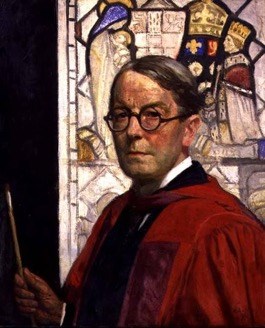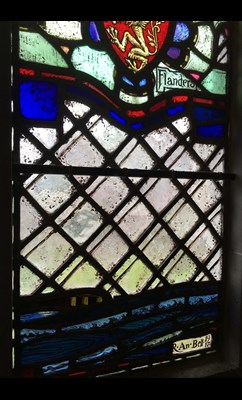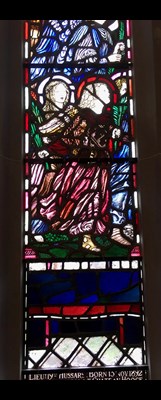I shall make Cornwall last as long as I can, as there won’t be such an opportunity to go and see things for a while to come. This time, I am talking about stained glass that we saw only a little over a week ago.
We made a special journey to the church of St Pol de Leon at Paul, on the hills above Newlyn. This was another brilliant suggestion from Bro. Ruth Guilding, as I had never been there before. The church has an immensely tall tower, so that ships at sea can use it to steer by. The nave seems very low by comparison, and this is partly explained by the fact that a group of Spaniards landed here in 1595 and caused fire damage, but the original granite columns were almost certainly used again in the rebuilding.

There are several fine and fascinating monuments inside the broad and brightly-lit interior. Our main interest, however, was the east window, a war memorial designed by Robert Anning Bell (1863-1933). You may recognise him from his portrait that hangs in the hall of the Guild, showing him with stained glass behind him, as he was Master in 1921. He was local to Holborn by birth, son of a cheesemonger in St Giles, just off Seven Dials. He went to University College School in Gower Street, worked for his uncle, who was an architecture, and was able to study art in London and Paris, coming back to share a studio in Camberwell with PM George Frampton, whose portrait with a prominent top hat hangs close to Bell’s.
In the early 1890s, Frampton and Bell worked together on painted low reliefs, which they exhibited, and some of which can be seen at the wonderful church of St Clare, Sefton Park, Liverpool. He also worked in mosaic, designing the panel on the Horniman Museum in Forest Hill (architect PM Charles Harrison Townsend) and at Westminster Cathedral (the tympanum over the west door) and in the Palace of Westminster. Writing about Bell in the Oxford Dictionary of National Biography (a great resource for Guild details which you may be able to read via a computer by logging in to your local public library), Peter Rose quotes a writer in the Studio magazine in 1911 who Bell’s ability to grasp 'the issues of the Italian Renaissance … its ability to revive in art remote experiences which have passed into its veins'. Bell started designing stained glass when he was teaching in Glasgow in the 1890s, with the studio of J. & W. Guthrie to help him. In his marvelous book, Arts and Crafts Stained Glass (Yale, 2015), Bro Peter Cormack quotes a lecture given by Bell to students at the Royal College of Art in 1922.

East Window at St Pol de Leon by Robert Anning Bell
Image by PM David Birch
‘Having trained as a painter, he had thought that “a stained glass window was the kind of thing you just did with charcoals and ‘genius’”; as a result he “learnt stained glass backwards. I began by designing windows, and then learned how to work them – designing them all wrong, and talking to the fellows in the shop and learning it that way.’


Detail of East Window by Master Alan Powers
By the time of his commission at Paul, he had plenty of experience, and examples of his work published in The Studio and shown with the Arts and Crafts Exhibition Society had a big influence. His window window commemorates Torquil Bolitho, the son of a prominent local family who died at Ypres in 1915. Unusually, his figure takes a central position as Sir Galahad, leading his horse, with haloed children, angels and a figure of Christ in the flanking lights. The tops of these lights are a reminder of the reality of the war, showing a journey across the battlefield, while the base of the window has the view of Mount’s Bay which lies beyond in reality.
Our visit was much enhanced by the vicar, the Rev. Andrew Yates, who described the major project to remake the decayed Polyphant stone tracery in Forest of Dean, and to re-set the glass, funded by HLF along with many other community activities about remembrance. He describes this in a short film here:
Posted on: 09 July 2020